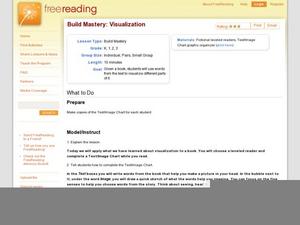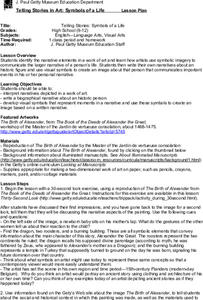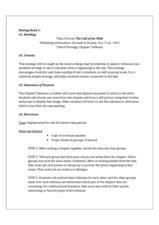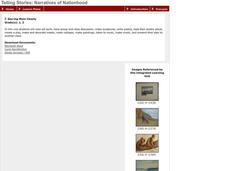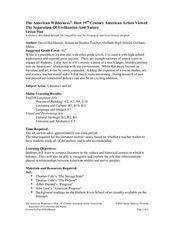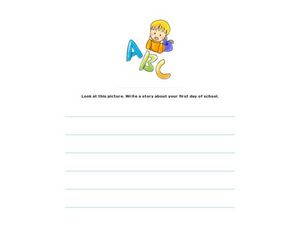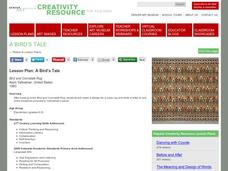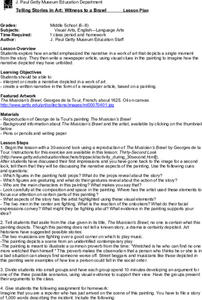Curated OER
Explore Cultural Diversity Through Art
Explore cultural diversity and build tolerance. Learners view art representing various cultures by Canadian painters. (Adapt with images or artists that reflect your demographics.) The class creates a collage or mural depicting cultural...
Curated OER
Basic Visual Language Ii: How To Analyze a Visual Text
Students identify techniques used to communicate visually. They compare and contrast different visual techniques found in mass media. They apply their understanding by creating photographs that use a variety of visual literacy techniques.
Curated OER
Build Mastery: Visualization
What do you see? Young reader tap into the visualization process as they listen to or read a fiction story and fill out a graphic organizer. Model this first with a think-aloud, showing scholars how you visualize a familiar story. For...
Curated OER
Telling Stories in Art: Symbols of a Life
Through a series of activities, learners are exposed to how artists use symbolic imagery to create the narrative of a subject’s life. They study The Birth of Alexander and some manuscripts kept at J. Paul Getty Museum. They then draft...
Maryland Department of Education
The Concept of Identity Lesson 8: Propaganda in Visual Media
Visual and print propaganda are featured in a lesson that asks readers of A Separate Peace to examine the techniques used in propaganda from World War I, World War II, presidential elections, and in the novel.
Curated OER
Visual Aural Impressions
Students view a piece of impressionist art, listen to a piece of jazz music and then write a piece about the picture in the style of beat poets. They compare their writing and look for differences in their perceptions.
Curated OER
Chapter Tableaux: Visualizing The Call of the Wild
Do your young readers have difficulty visualizing what they read? Although the activity described here is for The Call of the Wild, the strategy could be used with any narrative. At the conclusion of each chapter of Jack London’s novel,...
Perkins School for the Blind
Encouraging Students Who are Blind or Visually Impaired to Express Their Feelings and Explore Imagination
Being expressive in a creative, empathetic, or imaginative way is not only fun, it builds good pre-writing and communication skills. Learners with visual impairments have a roundtable discussion session where several sentence frames are...
J. Paul Getty Trust
Narrating a Family Tradition
After examining a piece of art, scholars discuss what they see, paying close attention to details and space. A read-aloud introduces the topic of family traditions. Pupils interview their family members about a tradition in preparation...
Curated OER
Step into the Painting: Social Studies, Literature, and Art
Travel back in American history to the era of slavery and abolition. After reading about the Underground Railroad, young historians examine a painting depicting the event, and write a narrative from the point of view of a person in the...
Curated OER
Sea-ing More Clearly
Explore works of art with your class by engaging them in a variety of artistic activities including papier-mache sculpture, poetry, performance, and more. After viewing and discussing four paintings of the sea by Robert Harris, learners...
Curated OER
Descriptive Writing: Using Art to Inspire description
Write with the senses! Try using art to inspire writers to consider all of the senses. Here, the class is divided in half. Each group looks at one of two images, imagines the senses that would be engaged, and records answers to five...
Curated OER
The American Wilderness? How 19th Century American Artists Viewed the Separation of Civilization and Nature
The attitudes of European settlers toward the American wilderness, as reflected in art and literature, is the focus of this resource packet designed for teachers. Included in the unit overview you will find lists or paintings and works...
Teacher's Corner
Seuss Visualizing
Only one thing can compare to the whimsy of Dr. Seuss: a child's imagination. Pair the bouncing narrative of a Dr. Seuss book with your learner's illustrations in a fun reading activity. As you read a selected passage, your class draws...
Curated OER
Writing Using a Visual Prompt: Child with A,B,C
As a way to encourage students to write, this short worksheet with a visual of a child saying the A,B,C's could be motivating. Learners write a short essay about their first day of school.
Curated OER
Visual and Meaning Cues
Learn how to apply visual and meaning cues to reading unknown words. Readers will explore what to do when they come to a word they do not know as they watch the teacher model the use of these cues and then participate in guided and...
Alberta Learning
Creating Persuasive and Effective Visuals
Advertisers know how to use persuasive techniques to create powerful visuals that inform and influence others. Class members examine these techniques and then demonstrate their knowledge as they craft posters, flyers, collages, etc. for...
Nasher Museum of Art at Duke University
Are You My Mother? An Opinion Writing Unit
During a five-day lesson, scholars analyze written and visual art—primarily the poem, Mother to Son by Langston Hughes— identify facts, and write opinions. Learners read the poem several times, discuss, write, compare and contrast, and...
UTSA Institute of Texas Cultures
Teaching Through Kamishibai and The Art of Chinese Calligraphy
Young learners discover kamishibai, a popular Japanese storytelling art, and explore how these Japanese folktales illustrate the country's cultural themes and values through discussion and storyboarding.
Curated OER
Lesson Plan: A Bird's Tale
Who wouldn't love to get a letter from a blue bird? Elementary art enthusiasts analyze the social and historical context of Ason Yellowhair's Navajo piece, Bird and Cornstalk Rug. They examine the construction and images on the rug...
Curated OER
Character Traits in Fables
Combining art, music, dance, and reading comprehension, this lesson is geared to reach all ability levels. After reading a variety of fables and discussing story elements and character traits, class members select a moral to use as the...
Curated OER
Telling Stories in Art: Witness to a Brawl
Students examine how a piece of art tells a story. In this visual art lesson, students interpret a piece of art work by writing a newspaper article that tells the story of the moment in time that is depicted in a picture. They work with...
Curated OER
I spy (Camouflaged Animals in Art!)
Students create a picture of a camouflaged animal in its habitat. In this visual arts lesson, students look at Hans Hoffmann's painting A Hare in the Forest and discuss the animal's camouflage. They research their own animal to create a...
Curated OER
The Power of Mental Images: Visualizing Literature
With a chapter book in hand, readers practice visualizing the events and characters of the story. The lesson gives suggestions of novels that are rich in detail to help facilitate the process. Drawings from what they read act as the...
Other popular searches
- Visual Art Self Portrait
- Visual Art Lesson Plans
- Teacher Resources Visual Art
- Visual Art Lessons
- Visual Art Lessons Symmetry
- Visual Art Tessellations
- Visual Art and Culture
- Visual Art History
- Visual Art and Math
- Visual Art Self
- Visual Art & Science
- Visual Art Tesselations




